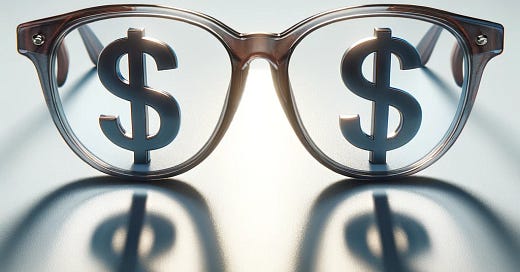How Giving People Eyeglasses Can Boost the Economy by $25 Billion a Year
Analyzing the Economic Ripple Effects of Affordable Eyecare
Correcting vision across the globe isn't just an act of charity—it's a $25 billion economic opportunity.
In this article, I explore research that shows how vision correction programs have not only transformed people’s lives but have also boosted local economies. From increased employment opportunities to reduced healthcare costs, the economic benefits of ensuring people who need glasses have them are a slam-dunk investment for world governments.
Correcting vision issues boosts worker productivity
Imagine if something as simple as needing reading glasses could impact the global economy.
That's exactly what a group of researchers explored in their study on presbyopia, a vision condition that makes it hard to see objects up close and typically begins to affect people as they enter middle age.
The study's main goal was to determine how much global productivity is lost to presbyopia when it is not corrected with glasses or surgery.
This is a big deal because, in many parts of the world, especially poorer countries, a lot of people don't get the glasses they need, and this could be slowing down their ability to work and, by extension, the economic growth of their countries. The less productive workers are, the less wealth a country is likely to have.
To find answers, the researchers used a mix of global data, including population figures from the US Census Bureau and health data from the Global Burden of Disease study.
They looked at how common presbyopia is, at what age it starts, and how it intersects with work and economics in various countries.
For example, they estimated the number of people who have this vision problem and aren't getting it corrected, then calculated how that could theoretically reduce a country's GDP or its total economic output.
This approach allowed them to put a dollar value on just how much productivity was lost because of uncorrected presbyopia around the world in 2011. It's a clever way of showing how a seemingly personal issue like needing reading glasses can ripple out and affect the bigger economic picture.
Seeing Green: The $25 billion opportunity of boosting productivity with eyeglasses.
Let's talk about what the researchers found in their study on presbyopia.
They discovered that in 2011, around 1.272 billion people worldwide were dealing with this condition—which is a huge number representing almost a sixth of the world's population at that time. What's even more interesting is how this affects worker productivity, especially when people don't have the right glasses to correct their vision.
Out of those 1.272 billion, about 244 million cases were people younger than 50. You might wonder, "Why focus on this age group?" Well, these are typically your active workforce members. The lack of proper vision correction in this group alone led to a staggering $11 billion loss in productivity globally.
That might sound like a drop in the bucket, and in a sense, it is. But, it's actually about 0.016% of the entire world's economic output in that year, just from not wearing the right glasses.
Now, if we consider people up to the age of 65—which includes more of the global workforce—the financial impact is even bigger. The potential productivity loss balloons to over $25 billion or 0.037% of global GDP. It shows just how much impact proper vision care can have, not just on individual health but on the global economy.
Interestingly, the study also simulated what would happen if every country corrected presbyopia as effectively as Europe, where around 96% of those needing glasses have them.
The result?
The global productivity loss could shrink dramatically to about $1.39 billion, or just 0.002% of the global GDP.
Research from VisionSpring found that for every dollar invested in programs to provide eyeglasses to people who can’t afford them, there is a return of $43 in increased income-earning potential at the household level. This impressive multiplier effect stems from the immediate improvement in productivity and quality of life that Clear Vision provides.
This scenario powerfully illustrates how improving access to something as simple as eyeglasses could significantly boost global productivity and economic health.
It's a small change that could have a massive impact on economies, especially in poorer regions where access to vision care is limited.
Final thoughts
Investing in affordable eye care is good for people who need glasses; it's also a smart economic development strategy for countries.
This kind of investment can pay off by reducing productivity losses, which can, in turn, drive faster economic growth, more tax revenue, and improved quality of life for millions.
It's a simple fix that could bring into focus a better future for countless individuals and economies globally.
Do you want to see more articles like this that focus less on personal finance and more on economic research?





"Proper Healthcare" is key. I went through a difficult experience getting my first glasses. The US healthcare system is beyond repair at this point and sales/money is the motivator. I was reeled in with a "2 for $99 Sale" and ended up with a $350 quote after they were done with me. Only after asking about the "sale" was it disclosed that it was for new customers that already have a prescription. I fell for their sham, hook, line and sinker.
I wear contact lenses and glasses. Working without them would be impossible.